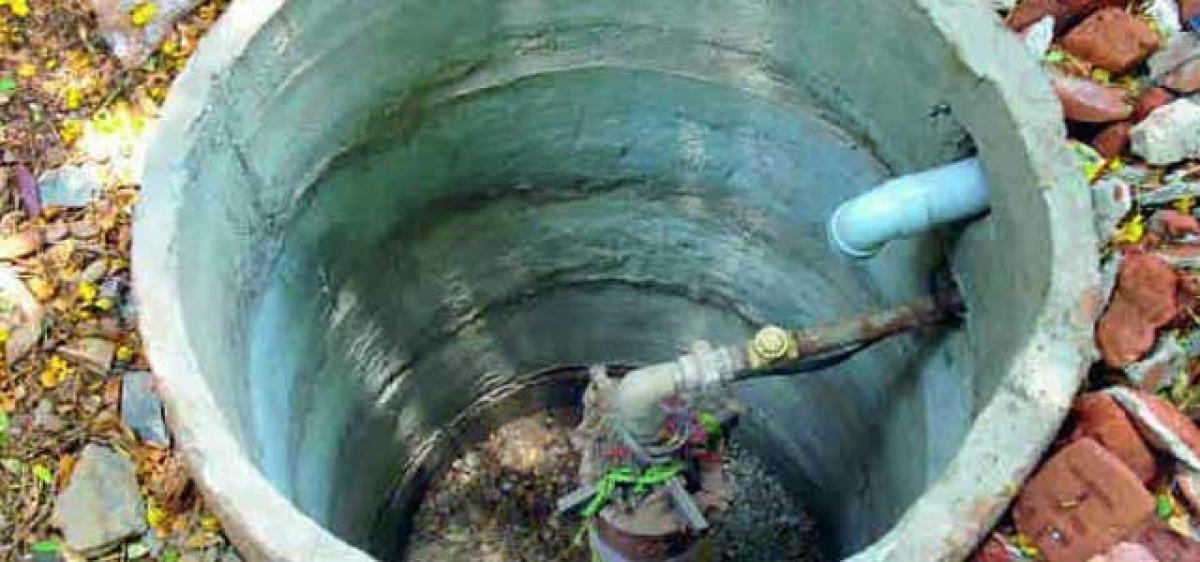Live
- PM Modi greets Minister Pralhad Joshi on his birthday
- Tirupati: Take up repairs of damaged roads, officials told
- Pawan Kalyan meets Vice President Jagdeep Dhankar, Continues Delhi Visit
- Heavy rain alert for Tirupati district due to low pressure
- EPACK Prefab constructs India’s fastest-built structure in 150 hrs
- Woman and her kids die under suspicious circumstances
- BMTC to increase bus running time on each route to drivers and conductors
- PDS implementation in Nalgonda sets a benchmark
- Ph D awarded
- BJP stands strong against Waqf Board misuse
Just In

With summer fast approaching, water levels in many bore-wells in the Greater Hyderabad limits are falling at an alarming rate, causing anxiety among the residents, as they are unable to locate the precious commodity even after digging for thousands of feet.
Hyderabad: With summer fast approaching, water levels in many bore-wells in the Greater Hyderabad limits are falling at an alarming rate, causing anxiety among the residents, as they are unable to locate the precious commodity even after digging for thousands of feet.
Experts attribute this problem to the plummeting groundwater levels and people’s failure to utilise rainwater at a time when water is fast becoming scarce. They point out that over 70 per cent of rain water is not being used.
Even though there are lakhs of houses in the Greater Hyderabad limits, only 50 percent of them have rainwater harvesting pits. This situation is leading to non-availability of water even after digging thousands of feet.
Even as the city’s population is increasing, there is no matching rise in groundwater levels, which are falling almost on a daily basis. Although the recent rain in the twin cities was expected to ease availability of water in early summer, the residents cannot escape shortage in March and April, warn experts.
According to HMWSSB officials, there are 1,014 power bore-wells in seven divisions of the twin cities. They include Charminar, Malakpet (division I), Bahadurpura, part of Malakpet (II), Yakutpura, Chandrayangutta, part of Nampally, Karwan, Jubilee Hills(III), part of Goshamahal, Khairatabad(IV), Mushirabad, Amberpet, part of Khairatabad (V), parts of Jubilee Hills, Khairatabad, Sanathnagar (VI), Secunderabad, Cantonment, part of Sanatnagar (VII).
Of these bore-wells, 710 only are in working. As many as 133 were recently repaired. Thus, a total of 843 are now available. Of the 5,295 hand bore-wells, 3,331 are working, while 729 were made functional, making the total 4,060, HMWSSBV Deputy GM , Central Zone Design Cell Md. Abdulla Quadir told The Hans India.
Prominent environmentalist Prof K Purshotham Reddy told THI that there was a need for creating public awareness about saving rainwater and show of commitment by the government to increase the groundwater levels, which were declining in all cities across the country by the day because of low input and high output.
Another reason, Reddy informs, is the abundant water bodies which used to work as water storage sources on the outskirts getting dried up. Although the population has increased along with water usage, more water bodies are becoming dry.
By: Veggalam Ramu

© 2024 Hyderabad Media House Limited/The Hans India. All rights reserved. Powered by hocalwire.com







